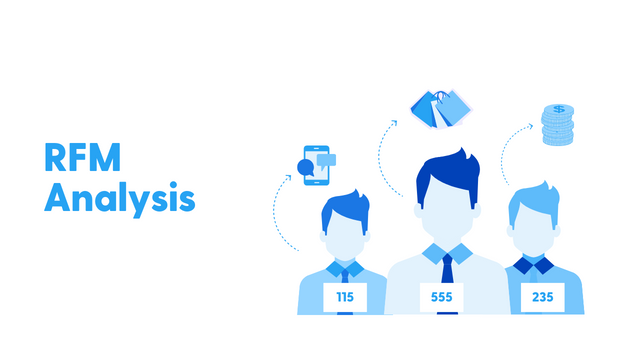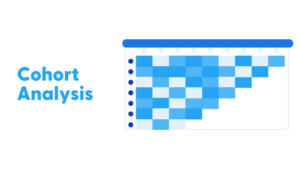RFM Analysis is a marketing technique used to identify and target the most valuable customers of a business. It is based on the idea that past behavior is a good predictor of future behavior, and that certain combinations of recency, frequency, and monetary value (RFM) indicate a customer’s value to the business.
RFM Analysis involves analyzing customer data to determine how recently a customer made a purchase, how frequently they make purchases, and how much they spend during each transaction. This data is then used to create segments or groups of customers based on their RFM scores. These segments can create targeted marketing campaigns and identify opportunities to upsell or cross-sell products to customers.
RFM Analysis is often used in conjunction with other marketing techniques, such as customer lifetime value (CLV) analysis and customer segmentation, to create more effective and personalized marketing strategies.
How to do RFM Analysis
To perform RFM analysis, you will need data on your customers’ purchase history, including the dates of their purchases, the number of purchases they have made, and the amount they have spent. You can use this data to calculate each customer’s RFM scores.
You can use the customer’s most recent purchase date to calculate the recency score. Customers who have made a purchase more recently will have a higher recency score. To calculate the frequency score, you can use the total number of purchases made by the customer. Customers who have made more purchases will have a higher frequency score. To calculate the monetary value score, you can use the total amount spent by the customer. Customers who have spent more money will have a higher monetary value score.
To perform RFM Analysis, a business will typically create a score for each customer based on their recency, frequency, and monetary value. The scores for each of these three factors are typically assigned on a scale from 1 to 5 or 1 to 10, with higher scores indicating more valuable customers.
Once you have calculated the RFM scores for all of your customers, you can use them to create segments or groups of customers based on their scores. For example, you might create a segment for high-value customers who have made recent purchases, made many purchases, and spent a lot of money. You can then use these segments to create targeted marketing campaigns and to identify opportunities to upsell or cross-sell products to customers.
When using RFM Analysis, one important consideration is ensuring that the scores are assigned fairly and accurately. This can be done by setting clear criteria for each score and using data from a representative sample of the customer base.
In addition to using RFM Analysis to identify the most valuable customers, businesses can also use it to identify trends and patterns in customer behavior. For example, a business may notice that customers with high frequency scores tend to have higher monetary value scores, or that customers with high recency scores are more likely to make additional purchases in the future. This information can be used to inform marketing and sales strategies and to improve the overall customer experience.
Overall, RFM Analysis is a useful tool for businesses looking to improve their customer retention and loyalty, optimize their marketing efforts, and increase their overall revenue.
Here’s an example of how we could rank the customers based on their overall RFM scores:
| Customer ID | Recency | Frequency | Monetary Value | RFM Score |
| 001 | 5 | 10 | 5000 | 15 |
| 002 | 3 | 5 | 2500 | 13 |
| 003 | 7 | 2 | 1000 | 6 |
| 004 | 1 | 15 | 7500 | 17 |
| 005 | 2 | 8 | 4000 | 12 |
| 006 | 10 | 1 | 500 | 2 |
| 007 | 4 | 6 | 3000 | 10 |
| 008 | 8 | 3 | 1500 | 4 |
| 009 | 6 | 4 | 2000 | 10 |
| 010 | 9 | 1 | 100 | 1 |
In this example, the customer with the highest RFM score is Customer 4, with a score of 17, indicating that this customer is the most valuable based on their recency, frequency, and monetary value. The second most valuable customer is Customer 1, with a score of 15, followed by Customer 2 with a score of 13.
RFM Analysis Examples
Here are a few examples of how businesses have used RFM Analysis to improve their marketing efforts:
- A clothing retailer used RFM Analysis to create targeted email campaigns based on customers’ RFM scores. They found that high-value customers were more likely to make a purchase when they received personalized, relevant email offers.
- A subscription-based meal delivery service used RFM Analysis to identify and target lapsed customers. They found that offering discounts and promotions to these customers increased the likelihood of them renewing their subscriptions.
- A B2B software company used RFM Analysis to identify and target high-value customers with upsell and cross-sell opportunities. They found that these customers were more likely to make additional purchases when they received personalized recommendations based on their purchase history.
- A sporting goods retailer used RFM Analysis to create targeted in-store promotions based on customers’ RFM scores. They found that customers who had a high monetary value score were more likely to respond to promotions for high-ticket items, while customers with a high frequency score were more likely to respond to promotions for lower-priced items.
RFM Analysis Tools
There are several tools and software platforms available that can help you perform RFM analysis. Some options include:
- Excel or Google Sheets: You can use a spreadsheet program like Excel or Google Sheets to calculate RFM scores and create segments of customers based on their scores. This can be a simple and cost-effective option for small businesses with relatively small amounts of data.
- Customer relationship management (CRM) software: Many CRM systems include RFM Analysis capabilities. These tools can help you automate the process of calculating RFM scores and creating customer segments based on those scores.
- Marketing automation software: Some marketing automation platforms, such as HubSpot or Marketo, include RFM Analysis capabilities as part of their suite of tools. These platforms can help you automate the process of creating targeted marketing campaigns based on RFM segments.
- Data visualization tools: Tools like Tableau or Power BI can help you visualize and analyze your RFM data, making it easier to understand and act upon.
When selecting an RFM Analysis tool, it is important to consider the size and complexity of your customer data, your budget, and the specific features and capabilities you need.
RFM Analysis for eCommerce
RFM Analysis can be a useful tool for eCommerce brands to identify and target their most valuable customers. In an eCommerce setting, recency, frequency, and monetary value can be calculated based on the customer’s purchase history.
For recency, you can use the customer’s most recent purchase date. For frequency, you can use the total number of purchases made by the customer. And for monetary value, you can use the total amount spent by the customer.
Using these metrics, you can create RFM segments of your eCommerce customers and use them to create targeted marketing campaigns and to identify opportunities for upselling or cross-selling. For example, you might target high-value customers who have made recent purchases and have a high frequency of purchases with offers for related or complementary products. Or, you might target low-value customers who have not recently made a purchase with promotions or incentives to encourage them to purchase.
Also, read:
RFM Analysis for Subscription Businesses
RFM Analysis can be particularly useful for subscription businesses, as it can help identify and target the most valuable customers based on their past behavior. Recency, frequency, and monetary value can be calculated differently in a subscription business than in a traditional retail setting.
For recency, you can use the date of the most recent subscription payment or renewal. For frequency, you can use the number of times the customer has renewed their subscription. And for monetary value, you can use the total amount the customer has spent on their subscription over time.
Using these modified definitions of recency, frequency, and monetary value, you can create RFM segments of your subscription customers and use them to identify upselling, cross-selling, and retention opportunities.
For example, you might target high-value customers who have recently renewed their subscriptions and have a high frequency of renewals with offers for additional products or services. Or you might target low-value customers who have not renewed their subscriptions recently with retention offers or incentives to continue their subscriptions.
RFM Analysis can be a powerful tool for subscription businesses, but it is important to remember that it is just one aspect of a larger marketing strategy. It should be used in conjunction with other marketing techniques, such as customer lifetime value (CLV) analysis and customer segmentation, to create a comprehensive and effective marketing plan.
RFM Analysis Template in Google Sheets or Excel
Here is an example of how you might create an RFM Analysis template using Excel or Google Sheets:
- Collect customer data: Gather data on your customers’ purchase history, including the dates of their purchases, the number of purchases they have made, and the amount they have spent.
- Calculate recency, frequency, and monetary value scores: Use the following formulas to calculate each customer’s RFM scores:
- Recency score: Calculate the number of days since the customer’s most recent purchase. Customers who have made a purchase more recently will have a higher recency score.
- Frequency score: Calculate the total number of purchases made by the customer. Customers who have made more purchases will have a higher frequency score.
- Monetary value score: Calculate the total amount spent by the customer. Customers who have spent more money will have a higher monetary value score.
- Create segments: Use the RFM scores to create segments or groups of customers based on their scores. You can use any criteria you like, but some common segments might include:
- High-value customers: Customers with high scores in all three categories (recency, frequency, monetary value)
- Low-value customers: Customers with low scores in all three categories
- Lapsed customers: Customers with low recency and frequency scores, but high monetary value scores
- Loyal customers: Customers with high recency and frequency scores, but low monetary value scores
- Use the segments to create targeted marketing campaigns: Once you have created your customer segments, you can use them to create targeted marketing campaigns and to identify opportunities for upselling or cross-selling. For example, you might target high-value customers with personalized offers or loyalty programs, or you might target low-value customers with promotions or incentives to encourage them to make a purchase.
This is just one example of how you might create an RFM Analysis template. You can customize the template to fit your specific needs and goals. It is important to regularly review and update your segments to ensure that they accurately reflect your customers’ current behavior and value.
Recap: Key Components of RFM Analysis
- RFM Analysis: A marketing technique used to identify and target the most valuable customers of a business based on their past behavior.
- Recency: The date of the customer’s most recent purchase.
- Frequency: The total number of purchases made by the customer.
- Monetary value: The total amount spent by the customer.
- RFM scores: The scores calculated for each customer based on their recency, frequency, and monetary value.
- Customer segments: Groups of customers based on their RFM scores.
Targeted marketing campaigns: Marketing efforts aimed at specific customer segments based on their RFM scores. - Upselling and cross-selling: Strategies to encourage customers to purchase additional products or services.
- Customer lifetime value (CLV) analysis: A technique used to calculate the value of a customer to a business over their lifetime.
- Customer segmentation: The process of dividing customers into groups based on characteristics such as demographics, behavior, or interests.
Using a Data Warehouse
A data warehouse can be an important component of an RFM Analysis strategy, as it can provide a central repository for customer data that can be used to calculate RFM scores.
A data warehouse allows you to store and manage large amounts of data from various sources, such as transactional databases, CRM systems, and marketing automation platforms. This data can then be used to calculate RFM scores and create customer segments based on those scores.
Using a data warehouse as the backbone of your RFM Analysis strategy can help ensure that you have a complete and accurate view of your customer data, which can improve the accuracy of your RFM segments and the effectiveness of your marketing campaigns.
In addition to storing customer data, a data warehouse can also store and analyze other types of data, such as sales, inventory, and financial data. This can be useful for creating a more comprehensive view of your business and for identifying trends and patterns that can inform your marketing strategy.
Conclusion
RFM analysis can help brands identify their most valuable customers and develop targeted marketing strategies. However, analyzing customer data can be challenging, particularly for organizations that don’t have a strong data foundation.
That’s where Saras Analytics comes in. Our data extraction and consolidation services can help you overcome data silos and identify your most profitable customers in conjunction with other growth analytics. By leveraging the power of RFM analysis, you can make data-driven decisions that increase customer satisfaction, loyalty, and profitability. Contact Saras today to learn more about how we can help you gain actionable insights from your customer data.













